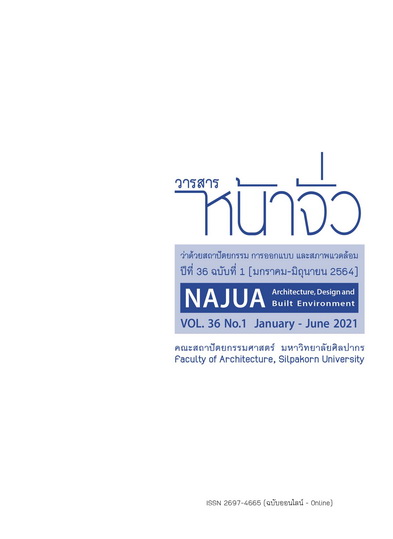แบบบ้านช่วงกลางคริสต์ศตวรรษที่ 20 ในประเทศไทย
คำสำคัญ:
กลางคริสต์ศตวรรษที่ 20, ความทันสมัย, สถาปัตยกรรมร่วมสมัย, สมัยใหม่, บ้านพักตากอากาศบทคัดย่อ
กลางคริสต์ศตวรรษที่ 20 ปรากฏบ้านที่นิยมแพร่หลายในอเมริกา หรือบ้าน Mid-Century ซึ่งต่อมาพบในหลายพื้นที่ในโลกรวมทั้งในประเทศไทยที่สามารถพบอยู่หลายพื้นที่ในประเทศไทยในช่วงเวลาหนึ่ง แม้ยังไม่มีคำนิยามหรือคำอธิบายเกี่ยวกับบ้านกลุ่มนี้อย่างชัดเจนนัก ซึ่งลักษณะภายนอกโดยรวมจะเป็นอาคารที่มีหลังคาความลาดชันต่ำผืนใหญ่กว้างและมียื่นชายคายาว จุดเด่นอีกประการคือ การจัดองค์ประกอบของแผงครีบแนวตั้งและแนวนอนภายนอกอาคาร อาคารหลายหลังพบการใช้ช่องเปิดเป็นแผงกระจกขนาดใหญ่เปิดเผยให้เห็นพื้นที่ภายใน ซึ่งในขณะนั้นถือว่ามีความแตกต่างไปจากบ้านเรือนไทยทั่วไปที่มักเป็นบ้านยกใต้ถุนและหลังคาจั่วลาดชันสูง พื้นที่ใช้สอยภายในถูกปิดล้อมค่อนข้างมิดชิดมากกว่า
บทความนี้ มุ่งเน้นศึกษาถึงรูปแบบบ้าน Mid-Century ว่ามีที่มาและจุดกำเนิดอย่างไร และพยายามอธิบายลักษณะเด่นและรูปแบบทางสถาปัตยกรรม รวมทั้งวิเคราะห์ถึงความสอดคล้องกับบริบทไทยหรือไม่อย่างไร โดยการศึกษาผ่านการทบทวนวรรณกรรมที่เกี่ยวข้องหลายรูปแบบ และเปรียบเทียบกรณีศึกษาในไทยกับต่างประเทศ ซึ่งผลการศึกษาพบว่า รูปแบบบ้านดังกล่าวน่าจะมีพัฒนาการมาจากบ้านบังกะโลสมัยล่าอาณานิคมในอินเดีย ต่อมาถูกพัฒนาสู่บ้านพักตากอากาศ ก่อนจะได้รับความนิยมและพัฒนาให้สอดคล้องกับบ้านพักอาศัยในยุคสมัยใหม่ในช่วงศตวรรษที่ 20 ที่ต้องการความสะดวกสบาย รองรับกิจกรรมที่หลากหลายในวิถีสมัยใหม่สอดคล้องไปกับบริบทแต่ละพื้นที่ รวมถึงบ้าน Mid-Century ในประเทศไทยก็สะท้อนถึงค่านิยมทางสังคมวัฒนธรรมเทคโนโลยีและบริบทที่กำลังมุ่งสู่ความทันสมัยในช่วงปี พ.ศ. 2500 แม้ว่ารูปแบบเหล่านี้จะลดความนิยมลงในภายหลังก่อนจะเริ่มได้รับความสนใจนำกลับมาปรับใช้กับวิถีปัจจุบันในหลายรูปแบบ การศึกษาเพื่อทำความเข้าใจเป็นส่วนหนึ่งเพื่อเติมเต็มองค์ความรู้ทางสถาปัตยกรรมในประเทศไทย ซึ่งอาจนำไปสู่การวางแผนการอนุรักษ์หรือศึกษาในเชิงลึกต่อไปในอนาคต
เอกสารอ้างอิง
Anthony D. King. (1995). The Bungalow The production of a Global Culture. Oxford University Press.
Horayangkura V., (1993). Development of Concept and Architectural Style: Past, Present and Future. BKK: The Association of Siamese Architects under Royal Patronage.
James Truslow. (1932). The American Scholar. The Phi Beta Kappa Society.
Kreangkrai Kirdsiri, and Other. (2022). Georgetown, Penang Island: from Historic Port Town to World Heritage City. BKK: Faculty of Architecture, Silpakorn University.
Nantanasirivikrom K. (2018). Thai’s House for seven decades (1946-2016). BKK: The Association of Siamese Architects under Royal Patronage.
ดาวน์โหลด
เผยแพร่แล้ว
รูปแบบการอ้างอิง
ฉบับ
ประเภทบทความ
สัญญาอนุญาต

อนุญาตภายใต้เงื่อนไข Creative Commons Attribution-NonCommercial-NoDerivatives 4.0 International License.





